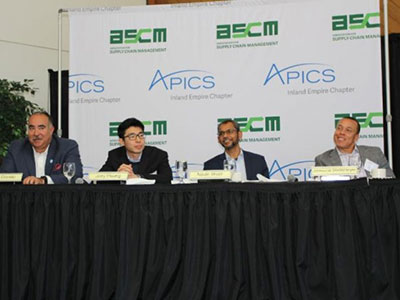We held an engaging executive panel discussion at our APICS Inland Empire spring symposium on the topic, “The Talent Transformation: People or Robots? There is quite a lot of hoopla in the area of Inland Southern California as this geography is larger than all but 24 states (and soon will take over Lousiana) with a strong manufacturing and logistics base yet the threat and opportunity of automation is close at hand. According to a University of Redlands study. Most large metropolitan areas are subject to losing 55% of their current jobs due to automation. In Inland Southern CA, that number expands to 62%. What will this mean? Disaster or opportunity?
According to a robotics expert with a background in industry, Carnegie Mellon and Harvey Mudd, the CEO of the Inland Empire Economic Partnership (IEEP), a Director at Honeywell and a recruiter and practice lead at Aerotek, we can rest assured that people and robots can co-exist successfully. Of course, this assumes we are proactive about thinking about automation, retraining and educating our workforce and providing the insights and collaboration opportunities such as the executive panel event.
We had some probing questions from the manufacturing and distribution professionals in the audience, but it was unanimous that a solution exists. We also talked about Middle Harbor which is a high-tech area of the ports. This has proven more challenging as negotiations have put some people out of a job yet still getting paid for it. With that said, there were many examples of success with business growing 3 fold while the company doubled the workforce and more. Hiding under a rock is definitely not the route to success. Instead, be a part of the collaborative effort. As a Board member of IEEP and a supply chain expert, I am helping to lead a consortium for advanced manufacturing and logistics success to address just this topic (resulting from the Brookings study research).
The students from Harvey Mudd presented some exciting robotics research they are conducting with industry on how to successfully navigate cluttered workspaces (as most manufacturing and distribution clients require). Much progress is being made, and robots aren’t going away. There are many positives in terms of consistency of quality, replacing competitive motion tasks, reducing workers compensation and labor risks in addition to cost savings. With that said, there are also some challenges to overcome which were discussed such as what happens when technology goes wrong (such as with the Boeing 737 Max). There is always risks to mitigate and people who are overlooked. The panel discussed the Challenger disaster and the employee who warned ahead of time to the technical glitch.
What are you doing to evaluate technology from a strategic standpoint? Will you be left in the dust? Grocery stores might have been a bit complacent before Amazon bought Whole Foods. Are you complacent? On the other hand, please don’t follow fads. When everyone thought outsourcing was great and Boards insisted on following the trend no matter the total impact, several companies outsourced and were sorry later when service went down and costs weren’t saved. If you’d like an assessment, contact us.



